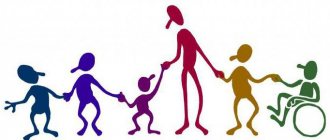Being an independent being, endowed with freedom of choice and creative potential, a personality cannot develop outside the social environment, outside interaction with other individuals.
Definition 1
In modern scientific literature, interaction is understood as the actions of individuals directed towards each other; a set of methods that a person uses in the process of achieving certain goals and solving practical problems.
The understanding of interpersonal interaction is based on the category of social connection.
Definition 2
A social connection is the dependence of individuals, which is realized through social actions carried out with a focus on another person with the expectation of an appropriate reaction from the participant in the interaction.
Are you an expert in this subject area? We invite you to become the author of the Directory Working Conditions
Content
1. Concept, types and functions of communication 3
2. The role of perception in the process of communication. Errors of perception 8
3. Workshop
Correlate the proposed socio-psychological concepts and their definitions:
a) stereotype;
b) prejudice;
1) one-sided, distorted and, as a rule, prejudiced view, characteristic of representatives of professional, age, social, ethnic groups or classes;
2) personal antipathy or active hostility towards another social group; however, individuals may or may not participate in discriminatory activities based on their views 13
Literature 15
The concept of “interpersonal relationships”
Each of us has our own principles, life values, moral principles, priorities and outlook on life. The interaction of one person with the people around him, the ability to establish connections with them is called interpersonal relationships.
There is a concept called “Donbar number”, which denotes the maximum comfortable number of connections for a person. Its value ranges from 100 to 230, with an average of 150 contacts.
Life in society is different, and therefore relationships are varied. Their variety depends on many factors and is classified into the following types:
- informal\formal;
- business\personal;
- practical\emotional;
- subordination\parity.
Let us consider each type of interpersonal relationship in detail below.
Concept of personality, communication and interpersonal relationships
In the context of psychology, a personality is an individual who acts as a subject of relations in society, as well as as a subject in his own conscious activity. Personality also means a system of properties of an individual, which manifests itself in human activity.
According to R. Cattell, personality is a concept that characterizes a person’s behavior in a given situation.
G. Allport believes that “a personality is something, and it does something. Personality is what lies behind specific actions within the individual himself.”
Comment
As you know, communication is inherent in a person as a social being. Without the latter, no interaction with other members of society can take place.
Thus, communication is a certain process in which interpersonal interaction takes place. This process is determined by the needs of the subjects who interact and is aimed at satisfying these needs.
Communication is more important than ever in the modern world, as the amount of information increases. In addition, the number of “person-to-person” professions is rapidly growing.
Definition 1
Interpersonal relationships are a set of connections that develop between people in the form of feelings, judgments and appeals to each other.
Note 1
Interpersonal relationships are based on communication. As is known, the very first leading activity of an individual (infancy) is emotional and personal communication. It is with its help that the psyche develops rapidly. Communication passes through the entire development of the child, and next time appears in the form of a leading activity in adolescence as intimate-personal communication.
There are several stages in the development of interpersonal relationships.
- Acquaintance. This stage is associated with the emergence of mutual contact and individuals’ assessment of each other.
- Friendly relations. The emergence of interpersonal relationships and the formation of a basic level of trust.
- Companionship. At this stage, a convergence of views occurs.
There are several main types of interpersonal relationships:
- Industrial interpersonal relations.
- Everyday interpersonal relationships.
- Formal interpersonal relationships.
- Informal interpersonal relationships.
Ways of human interaction with society
Psychologists describe 4 possible ways of interaction between an individual and a team:
- Initiative type of behavior. The acting person himself influences the environment. He is able to change the conditions of interaction in his team as he needs.
- Reactive type. A person is able to adapt to environmental conditions. But he himself does not influence her.
- Interpretive.
- The evaluator - the social environment influences him, he himself remains passive, only reflexively assesses what exactly is happening to him.
Naturally, those who choose an active position rather than a passive one are more successful in society.
Interpersonal relationship systems
In addition to the above types of relationships, there is also a systematic division into rational and emotional relationships, as well as parity and subordination. Let's look at them in more detail:
- Rational relationships. It logically follows that the basis and goal of this type of relationship is the intention to receive benefits. A rational system of relations implies a certain mutual benefit for all participants in the communication.
- Emotional social connections are based on personal preferences, based on sensory contacts, which may not always be positive. Along with friendship and love, emotional relationships also include enmity, antipathy, and hatred.
- Parity contacts - communication between a couple or a group of people in this category is based on equality. The basis of these interpersonal relationships is complete freedom of choice.
- Subordination relationships that have a clear hierarchy. For example, this could be communication between a boss and subordinates.
Communication goals
The goal is the strategic result that each participant in the interaction strives for. In essence, interpersonal relationships are the desire of both parties for a pre-thought-out outcome. Goals can be completely different
- Getting help.
- Self-expression.
- Finding a partner for entertainment.
- Seeking emotional support.
- Training or education.
- Introduction to cultural principles.
- The desire to dominate a weaker partner.
The most popular purpose of communication for young girls is simply to share experiences. For young students, this is an exchange of thoughts and a community of interests.
Interpersonal relationships and interactions will only be built when both find this communication mutually beneficial and consistent with their moral values and goals.
Ways to improve interpersonal communications
Any communication involves the interaction of people with each other. In order for every conversation to be successful, psychologists pay a lot of attention to the development of interpersonal communications. By adhering to the following rules during contact with an opponent, you can significantly improve interpersonal communications:
Learn to abstract yourself from psychological barriers, which are a significant obstacle to fruitful communication. Internal barriers can arise quite often during a conversation. You can avoid them by concentrating on important points during the conversation. Don't forget about good manners and charm. Many people have access to such a “superpower” as charisma, thanks to which they can get everything they need from communication without any problems. This trait is not exclusively an innate quality, which means that it can be developed. Say “no” to psychophysical clamps. Loose or too constrained body movements will become a signal to the interlocutor about the presence of psychological and physical abnormalities. Perhaps the opponent will not be able to give a clear definition of this state, but he will immediately sense that something is wrong. In this regard, the success of your conversation will be in great question.
To avoid such cases, it is important to be able to relax during a conversation and, of course, to train. Become a protégé. If among your friends or acquaintances there are people who are excellent at communication, then you should try to watch them and imitate
By adopting an already proven model of behavior, you can achieve significant success. Talk as much as possible, especially for very shy people. Conversations on abstract topics about which everyone can express their opinion can help save you from feeling embarrassed: about the weather, about gasoline prices or traffic jams. This simple secret will help improve interpersonal relationships. Communication implies active interaction between individuals, but we should not forget that all people are different, and the approach to each should be purely individual. By communicating daily on a variety of topics with those around you, be it a work colleague or a supermarket clerk, you will gain invaluable experience in communicating in different styles and increase your self-confidence. Master the art of asking questions. Scientific research has shown that asking the right question is half the solution to the problem. During the conversation, the correct and accurate question will be the one that the opponent wants to answer and think about. In order to get a communication partner to talk, it is worth using open-ended questions, which usually begin with the words “why”, “why”, “how”, etc. In addition, during the conversation it is important to soften the questions so as not to offend the interlocutor.
Your psychologist. The work of a psychologist at school.
| Communication as people's perception of each other |
| Communication as interaction |
| Types of Interpersonal Interaction |
| Communication style and I-statements |
| Mechanisms of psychological influence: suggestion, infection, persuasion |
| Means and techniques of psychological influence |
| Ethics of business communication |
| All pages |
Page 5 of 9
1.7. Types of Interpersonal Interaction
E. Berne identifies various forms of interpersonal interaction: affection, friendship, love, competition, care, pastime, surgery, play, social influence, submission, conflicts, ritual interaction and others. They are characterized by specific positions. One of the common forms is ritual interaction, which is built according to certain rules, symbolically expressing real social relations and the status of a person in a group and society. Ritual acts as a special form of interaction, invented by people to satisfy the need for recognition. In this case, the Parent-Parent relationship dominates. Thanks to such interaction, the value of the group is revealed, people express what affects them most, constitutes their social value orientations. The English scientist Victor Turner, considering rituals and rites, understands them as prescribed formal behavior, as “a system of beliefs and actions performed by a special cult association.” They are important for maintaining continuity between different generations in a particular organization, for preserving traditions and passing on accumulated experience through symbols. Ritual interaction is both a kind of holiday that has a deep emotional impact on people, and a powerful tool that maintains stability, strength, continuity of social ties, a mechanism for uniting people, increasing their solidarity. Rituals, rituals, and customs are capable of being imprinted on a subconscious level, ensuring the deep penetration of certain values into group and individual consciousness, into ancestral and personal memory. Humanity has developed many customs: religious rites, palace ceremonies, diplomatic receptions, military rituals, social events, holidays and funerals . Rituals include numerous norms of behavior: receiving guests, greeting acquaintances, addressing strangers, etc. A ritual is a rigidly fixed sequence of transactions, and they are carried out from the position of the Parent and addressed to the same position, allowing people to feel recognized. If a person’s need for recognition is not fulfilled, then aggressive behavior begins to develop. The ritual is precisely intended to remove this aggression, to satisfy the need to be recognized at least minimally. With another type of interaction - operations - the transaction is carried out from the position of Adult - Adult. We meet with them every day: at work, at school, when preparing food, renovating an apartment, etc. Having successfully completed an operation, a person is confirmed in his competence and receives confirmation from others. Labor interaction, distribution and implementation of professional. family functions, the skillful and efficient performance of these duties - these are the operations that fill people's lives. Competition is a form of social interaction where there is a clear goal to be achieved, and all the actions of different people are related to this goal so that they do not conflict. At the same time, the person does not come into conflict with himself, adhering to the attitude of another team player, although he has an inherent desire to achieve better results. than other team members. Since a person accepts the attitudes of other people and allows him to determine what he will do in accordance with some common goal, he becomes an organic member of his group, society, accepting its morality and becoming a significant member of it. In a number of cases, being in the same room with other people and performing seemingly joint activities, a person mentally remains in a completely different place, talks with imaginary interlocutors, and dreams about his own. This specific interaction is called grooming. This is a common and natural form of interaction, but it is still more often resorted to by people who have problems with interpersonal needs. If a person has no other forms of interaction left except care, then this is already a pathology - psychosis. The next type of approved fixed interactions is a pastime that provides at least a minimum of pleasant sensations and signs of attention from partners. Pastime is a fixed form of transaction designed to satisfy people's need for recognition. If this form is implemented from the Parent-Parent position, then most often it is expressed like this: everything that deviates from the norm is discussed and condemned (children, women, men, government, television, etc.). Or this may be the case when discussing the topics “Things” (comparing owned cars, televisions, etc.), “Who won yesterday” (football and other sports results) - this is the pastime of men; “Kitchen”, “Shop”, “Dress”, “Children”, “How much does it cost?”, “Do you know that she ...” - topics for women. During this process, partners and prospects for developing relations with them are assessed. Sustainable interaction between people can be caused by the emergence of mutual sympathy and attraction. Close relationships. Providing support and companionship (that is, we feel loved, approved, and encouraged by friends and loved ones) are associated with feelings of happiness. Studies have shown that such positive relationships improve health and reduce the likelihood of premature death. “Friendship is the strongest antidote to all misfortunes,” said Seneca. Forms of interaction such as friendship and love satisfy people's need for acceptance. They are outwardly similar to passing time, but in these cases the partner is fixed, and sympathy arises towards him. Friendship includes sympathy and respect; love differs from it by its enhanced sexual component, that is, it equals: sexual attraction + sympathy + respect. In the case of falling in love, there is only a combination of sexual attraction and sympathy. These forms of interaction differ from all others in that they necessarily contain hidden Child-Child transactions expressing mutual recognition and sympathy. People can discuss any problems they want, even on a completely adult and serious level, but in every word and gesture they will take into account: “I like you.” Some features are characteristic of all friendly and loving attachments: mutual understanding, dedication, pleasure from being with a loved one, care, responsibility, intimate trust, self-disclosure (discovering innermost thoughts and experiences in front of another person). “What is a friend? This is the person with whom you dare to be yourself,” noted F. Crane.
1.8. Syntonic model of communication
The name “syntonic” is derived from the word “syntonia”, which means: “To be in harmony with oneself and others.” The syntonic model of communication was developed within the framework of neurolinguistic programming (NLP). Neuro-linguistic programming is the result of a fusion of psychology, linguistics, mathematics; NLP techniques are successfully used in pedagogy, management, psychotherapy, and business. The syntonic model identifies the basic communication skills (determination of desired goals, sensory acuity, flexibility, congruence, rapport, resource state) and divides the process of mastering it into parts, or steps. If you want to successfully interact with people, you need to master these steps through specific practice exercises. The syntonic model of communication views communication as the result of a complex interaction between the processes of perception and thinking (perception + thinking = communication). The process of communication begins with perception; it is with its help that a person establishes contact with the world and people. Our senses are like five doors that we open to collect information about the surrounding reality. Our consciousness opens these “doors” in turn: for one person, first for pictures, then for smells, for another - first for sounds, then for touches. This is a very fast sequence. But. however, consistency. Our subconscious mind perceives information through all five channels simultaneously and receives much more information than our conscious mind. The syntonic model of communication is based on the idea that each person has his own “favorite door of perception” - that representative system that he trusts more than others. For example, if your favorite system is visual (visual), then you perceive and store the world in “pictures” in your memory. It has been established that the leading representative system is externally manifested in eye movements, choice of words used in communication, breathing patterns and even posture. If you know which representational system your communication partner prefers, you can use words that correspond to his “favorite” perceptual model. People with a visual model of perception easily understand some words, while people with an auditory (auditory) and kinesthetic model easily understand others. If you choose and use words correctly, in accordance with the leading representative system of the interlocutor, you will be considered a person with whom it is pleasant to communicate, with whom it is easy to establish contact and mutual understanding. How do you know which representational system a person prefers? To do this, you need to carefully watch him. The words he uses will say a lot. His nonverbal behavior will be even more eloquent: eye movements, tempo and timbre of voice, breathing, posture. This important information cannot be faked, it comes straight from the subconscious, it is only important to learn to recognize and use it. A person with a visual representational system, when about to say something, searches through pictures in memory to determine what is happening at the moment. This happens very quickly and his eyes are unfocused on a spot about 60 cm from his nose. If you stand directly in this place, you can prevent such a person from thinking: he may even get angry. In the speech of visual people, words of visual meaning predominate: “see”, “clear”, “colorful”. “I see what you mean,” etc. Their speech rate is higher than that of people with auditory and kinesthetic representational systems. A person with an auditory representational system, when about to say something, listens to his inner voice. It is difficult for him to make a choice: his inner voice constantly leads the discussion, not knowing what to give preference to. The person's stasis at this time is looking to the right or left, moving along the midline or going down and to the left. The speech of auditory people is dominated by the following words: “I’m listening to you”, “let’s discuss”, “what tone”, “intonation”, “screams”, etc. People with a kinesthetic representational system listen to their inner feelings before speaking , and their eyes involuntarily look down to the right. In the speech of kinesthetics, the dominant words are: “touch”, “touch”, “tangible”, “painful”, “heavy”, “I feel a problem”, “it’s hard on my soul”, etc. Another type is added to the classical triad of people - “rational people” or “computers” are those who react not to their sensations, but to designations, names, words, “labels” that designate all their sensations and images. Their eye movements are difficult to catch; they prefer to use words: “we need to figure it out,” “let’s analyze,” “systematize,” etc. Basic communication skills Determining the desired results. Communication without results is like a journey without a goal. The result is what you want to see, hear and feel. NLP offers four ways to clarify goals and turn them into results: 1) clarify the result (precisely define the desired result); 2) formulation of the result in a positive form, for example: “I want to be rich” - a positive positive form, “I don’t want to be poor” or “I don’t want to look funny” - these are results formulated in a negative form. And this is an unproductive way to communicate. In fact, there is no need for a person to strive for what he does not want. He is more likely to succeed if he strives for what he wants. Therefore, it is better to formulate it in a positive form; 3) isolating sensory indicators of the result; To do this, you need to answer the questions: “What will I see when I achieve the result?”, “What will I hear?”; 4) agreeing on results with a communication partner: most people will help you achieve your results if they simultaneously achieve their own. If you achieve results against the interests of others, you are manipulative and people will obstruct your success, openly or covertly. Those who manipulate others usually face the four “dragons”: resentment, blame, remorse and revenge. So, communication begins with clarifying the results. And immediately think about how you will coordinate your desires with the completely fair claims of your communication partner. Sensory acuity. Every person has a sensory sense that helps him see, hear, and feel changes in the behavior of his communication partner. Sensory sense is necessary to control the communication process, ensuring successful progress towards the result. Some signals in the interlocutor's behavior may suggest that the wrong step has been taken or that it is necessary to retreat a little in order to achieve the goal. The ability to consciously maneuver is especially necessary in confusing situations. Sensory acuity helps to notice the smallest changes in the behavior of the interlocutor: after all, a person’s internal thoughts and emotions are manifested through external behavior (body postures, swaying, head tilts, shoulder movements, hand gestures). There are also more subtle changes: in skin color, muscle tone, breathing rate, momentary trembling of the lower lip. These subtle unconscious visible reactions in NLP are divided into four groups: changes in skin color, changes in inhalation, changes in the lower lip, momentary changes in muscles. Unconscious visible reactions are valuable because they are not subject to a person's conscious control and therefore contain true information. These subtle changes are difficult to notice without proper training. When learning sensory work, you need to master three steps. 1. Fixing changes in human behavior (practice every day in observing people, but remember the rule: “Stop, listen, look, turn on your intuition, but do not rush to interpretation”). 2. Distinguishing patterns, i.e., repeating moments in human behavior. Look carefully at those who are nervous: some shift from foot to foot, turn pale, others quickly pace around the room, clench their fists, bite their lips. And this happens every time in moments of nervous experiences. Such repeated specific changes in body posture, movements of the head, arms, legs, facial coloring, breathing rhythm, voice tempo are called patterns. 3. Calibration, i.e. recognizing a certain state of a person by his non-verbal signals, establishing a connection between the external pattern of a person’s behavior and his internal state. (At first, while you have little experience, you can clarify this with your interlocutor. Were you nervous when you said: “No need for sugar?” And to yourself you can add: “And you had pale spots on your face, you were shifting and listening to something.” .) NLP experts warn that you can fall into a dangerous trap if you interpret changes in the external behavior of the interlocutor based on your experience. The same external reaction can have completely different meanings for different people. Each person is individual and generalizations must be avoided. Flexibility. The communication process largely depends on the flexibility of the interlocutors - the ability to change their behavior depending on the circumstances, to respond to the behavior of their partner. Learning to be flexible means gaining the ability to see in a partner’s behavior the peculiarities of his perception and thinking and, by varying your behavior, achieve mutual understanding and achieve your goals. The NLP rule says: “If what you do doesn’t work, try something else.” In communication, it is important to be flexible in words, thinking, perception and behavior. Sensory acuity allows you to be flexible in perception. Flexible behavior has advantages: new behavior provokes new responses and... Perhaps you will achieve the desired result by using different new ways of behavior. To gain flexibility, you need to master three steps: 1 - interrupt old patterns of behavior (for example, take a different route to work, or in situations where there is no risk, stop what you are doing and think of three new possible ways to achieve it the same result, or, for example, do not speak for one week, write notes warning family and friends that you are conducting an experiment); 2 - invention and use of new opportunities and new ways of behavior. (For example, look at the world through new glasses, imagining for an hour that you are not you at all, but your neighbor on the landing. What does the world look like from his point of view? Imagine ages - 17 and 39 years old. What does life seem like to you at 17 years? And at 39?); 3 - a rapid sequence of interrupting old patterns of behavior and using new choices (for example, when you notice that the inner voice orders you: “You must!” - change your behavior, play a different role, be someone else for at least three minutes Or another exercise: in the middle of an argument, step back and tell your interlocutor: “You are completely right. What do you want now?”). Congruence. The word "congruence" comes from the Latin "congruens", which means "to meet and agree." Each of us has many different “parts”: a business person, a boss, a parent, a critic, a player, an ambitious person, a merry fellow, a conqueror of hearts, etc. If all parts of the personality act in concert, they unite, directing their efforts to achieve a result that is important to us. everyone, while choosing a single way of interaction - you are congruent. If we say one thing, do another, and want something completely different, then we are incongruent and our state is noticeable to the people around us. If parts of our personality have not yet decided what we really need, if there are any contradictions and disagreements about how to achieve results, we may say “yes”, but at the same time we will involuntarily shake our heads negatively, and a serious phrase may unexpectedly end with a short laugh . All this is seen by the people with whom we communicate, and this behavior causes confusion, doubt, and mistrust of us. As a result, the chances of successfully achieving results decrease. To be congruent is to take an important step towards achieving inner integrity. The syntonic model not only emphasizes the importance and necessity of congruence, but also offers six steps to master it: 1 - distinguishing between states of congruence and incongruence in order to recognize your state of congruence (a state of 100% involvement, focusing all forces on the task at hand) and incongruence (a state of internal confrontation, conflict with oneself, contradiction of desires, words, thoughts and deeds); 2 - getting to know different parts of your personality. This step is extremely important, since the most difficult problems for a person arise when some parts of his personality are not familiar with each other and do not even know that they are in conflict. In order to avoid such troubles, NLP experts suggest that a person realize and write down what roles he plays in his life, what desires he has, what parts of his personality are characteristic of him, and give them a name (name): for example, wife, mother, the ambitious part, the creative part, the cook, the production and business part, the coquette, the seductress who protects honor, the adventurer, the playful part, etc. Then it is useful to hold a “general meeting” of the main parts of your personality, and it is important to “see” and “hear” ", "feel" each part. How does she usually announce her existence? How do you feel it in your body? Where does it live - in the head, in the hands, in the legs? What might she look like? 3 - Determining the goals, intentions and desires of each part of the personality is a very important step towards congruence. We can only be congruent when we know exactly what we want. what results are we aiming for? At the same time, it is necessary to remember that all our parts, in one way or another, want our good and express our desires. We most often do not realize the full complexity of our inner life, and therefore we must give the floor to each part so that they reasonably declare their desires and what goal they are pursuing; 4 - determination of priority goals, i.e. you should determine what you need to achieve first of all, what goal may be the most important at present and in the future; 5 - achieving agreement between different parts of the personality that they recognize the established priority of goals - only then will you be congruent in your actions, gestures, intonations, in the choice of words and your communication will maximize the achievement of the desired results; 6 - concluding a “contract” on an accepted agreement (concluding a contract consolidates the agreement reached, shows respect for parts of the individual and is a guarantee that negotiations and the time spent on them are not just entertainment, but serious work). So, before you start any important task, check what condition you are in. And if you recognize the signals of incongruity, negotiate with yourself, with your parts of personality, try to reach agreement between them, draw up a written agreement on the issue under discussion and instruct the conscious part to monitor the decision made. If you learn to create harmony between the parts of your personality, you will notice how much more effective your communication, your activities and your overall life will become.
<< Previous — Next >>
Forms of interpersonal interaction
As a social being, man cannot help but communicate. Even when a writer creates a book in solitude, even in this case communication between him and the reader is assumed.
The following forms of communication are distinguished:
Friendly interaction is communication at a close psychological distance, which brings mutual pleasure and joy. Love is an intimate interaction between two people that leads to the development of both partners as individuals. Interaction in a student group or interest groups. Relationships within the work team. Communication in a psychological support group.
Relationships are divided in psychology into official and informal, personal and business. Establishing relationships and developing them is a delicate process that depends on many factors; and, first of all, from the ability to build social contacts.
Interpersonal interaction in a group is difficult to organize. The possibility of the group breaking up is high here; Without a good leader who can smooth out contradictions and give the team the mindset for high-quality teamwork, there will be no interaction.
Some people can maintain good friendly relationships with everyone in a business environment. These are people with high emotional intelligence and experience in the field of communications. They are social leaders by nature and, with the development of certain qualities, can become good managers.
Peculiarities
Each concept in science has characteristic features that need to be studied so that the object of study can be analyzed in more detail.
What features of interpersonal interaction are described by specialists in the field of social psychology?
- Multichannel. Interaction occurs at both verbal and non-verbal levels.
- Stages of establishing relationships.
- Productivity.
- Irreversibility. The emotional impact on a person is truly irreversible.
Another important feature for establishing relationships is having sufficient communication experience. Experience in communication is a set of ideas about successful tactics for establishing and maintaining the necessary distance in communication. Those who work in the “person-to-person” system must have such experience.
Basics of proper communication
The main problem of interpersonal relationships is a violation of communicative function. If a person does not know how to communicate correctly and is afraid to establish contacts with people, then any type of interpersonal relationships are unlikely to develop successfully.
Useful tips
There are several effective tips on how to learn to communicate with people:
- Be interested in what the other person is saying. Learn to listen.
- Watch your facial expressions. Smile more often.
- Call your interlocutor by name more often. According to numerous psychological studies, the sound of one's own name is one of the most pleasant to the human ear.
- Get rid of filler words. They make your speech vulgar and uncomfortable to hear.
- Develop a culture of speech. When a person speaks correctly and beautifully, it is not only pleasant to listen to him, but also much more understandable. After all, the ability to clearly and clearly formulate your thoughts guarantees that the interlocutor will also understand them.
There are situations when, during communication, people cannot find the right words, do not know what to talk about and how to build a constructive dialogue. As a result, misunderstandings arise in relationships.
Communication mistakes
What communication mistakes should you try to avoid so that types of interpersonal relationships are not at risk of unfavorable development?
- Watch your tone, facial expressions and gestures. Avoid an indifferent tone, a bored look, skeptical assessments - such manifestations discourage the desire to continue communication.
- The language barrier. This is not just a problem of people speaking different languages. Also, a language barrier can arise between people with different levels of development, age characteristics and speech culture. For example, you won’t be able to talk with children the same way as with adults, if only because most of the words and terms that adults use in conversation may be unknown to children.
- Manifestations of social phobia. It happens that a person, for inexplicable reasons, feels afraid of communicating with people. This is why awkward situations and pauses arise when trying to establish contact with the interlocutor. If you are faced with a similar problem, then you need to show inner willpower and resilience to work on improving your communication functions.
Every person is born and lives in society throughout his life. Complete isolation is completely impossible. There are options to trim and reduce the types of interpersonal relationships, leaving only the most necessary areas of social connection. But without successful construction of social communication connections, harmonious personal growth and development is impossible.
Interpersonal communication, its psychology
The procedure in which individuals interact for the purpose of mutual knowledge, the development of relationships, as a result of which mutual influences on the behavior and views of the participants in such connections are manifested, is regarded as the psychology of interpersonal communication.
After all, communications (communication) turn out to be one of the key categories of psychology and are considered by it on equal terms with such categories as:
- Behavior
- Thinking
- Personality
- Relationship
What is meant by communication in psychology? First of all, human relations, implying various configurations of the general activities of individuals. Most often, communication and activity are recognized as different aspects of social human existence, or communication is understood as a separate element of a particular activity, considered in turn as a condition for communication. When communicating, people exchange their views, emerging ideas, and feelings.
The difficulties of interpersonal communication and interaction are manifested through the emergence of motivational and operational difficulties that correlate with the interactive and communicative aspects of communication. Characteristic signs are a lack of desire to comprehend the personality characteristics of the interlocutor, his interests and internal state. As a consequence, there are manifestations of communication problems with the desire to benefit from communication with the interlocutor through his deception, intimidation, or demonstrating extreme concern for him.
What does social psychology study?
Problems of interpersonal social interaction are assessed by specialists in the context of the following issues:
- Studying the cognitive (cognitive) processes of each participant in the interaction.
- Study of the constituent characteristics of the environment: spatial, social, physical characteristics. And the aspect of a social group is also taken into account - a student environment, a city council meeting or other association of individuals.
- The study of both the system of an individual and the influence of the environment on it.
Many scientists participated in the development of this social science - L.V. Smolina, Yasvina, Panova, etc.
Formation of interpersonal relationships
The development of interpersonal relationships is possible only under one condition - if the individual has the ability to establish contacts with people and find a common language with them. This is facilitated by ease and contact, trust and understanding, emotional attraction and acceptance, as well as the absence of a rigid program of manipulation and self-interest.
Interpersonal relationships ideally strive for trust, this includes the expectation of support and confidence that the partner will not betray or use the situation for harm.
In the process of trusting interpersonal communication, relationships deepen and psychological distance decreases. However, trust often develops into gullibility, which is expressed in the fact that an individual unreasonably believes a person’s word, despite pitfalls and disappointments.
Analytical models
Psychological, information-communicative and social-normative processes that make up the subject area of the theory of interpersonal communication are studied in various disciplines of the humanities. Among them are personality psychology and social psychology, linguistics (especially psycho- and sociolinguistics), sociology (primarily such areas of microsociology as symbolic interactionism and dramaturgical sociology). Thus, the theory of interpersonal communication fundamentally turns out to be a sphere of interdisciplinary knowledge. Moreover, its development is stimulated by interdisciplinary connections.
BIBLIOGRAPHY
1. Krysko V.G. Social psychology: Course of lectures – 3rd ed. – M.: Omega-L, 2006. – 352 p.; table, ill. - (Higher School Library.).
2. Lavrinenko V.N. Psychology and ethics of business communication: Textbook for universities. – 4th ed. reworked and additional – M.: UNITY-DANA, 2005. – 415 p.
3. Morozov A.V. Business psychology: Course of lectures. – St. Petersburg: Publishing house SOYUZ, 2000 – 576 p.
4. Stolyarenko L.D. Psychology of business communication and management. Textbook. - Rostov-on-Don: Phoenix, 2005. - 416 p.
5. Shelamova G.M. Business culture and psychology of communication: A textbook for beginners. prof. education. — 7th ed., erased. - M.: Publishing House, 2007. - 160 p.
Levels of interpersonal relationships
Definition 4
The level of interpersonal relationships is the depth of a person’s involvement in interaction with other people (person).
The following levels of interpersonal relationships are distinguished:
- The perceptual level of interpersonal relationships is the level of understanding and perception by partners of each other, awareness of individual personality, character traits, behavior and characteristics (gender, racial, external, national, etc.). At this level, interpersonal relationships between people are just emerging and developing. People recognize each other and begin to experience the first emotional reaction.
- Mutual attraction or rejection is the level at which partners experience first feelings for each other (liking, antipathy, hostility, etc.). That is, there is a deeper acquaintance with the person.
- The interactive level is a level characterized by the presence of emotional reactions that require constant feeding through interaction between people. So, if people feel sympathy for each other, then they strive to interact, collaborate, and communicate as much as possible. If, on the contrary, they experience negative feelings towards each other, then they try to avoid contact so as not to lead the situation to conflict.
Almost all types of interpersonal relationships go through all three levels of development. After reaching the third level, interpersonal relationships stop developing, as they have reached their maximum. In the future, the relationship may remain at the final stage, that is, people will experience established feelings for each other and their interpersonal relationships will be relatively “smooth.” It may also be that the relationship will change, based on a decline in emotionality and a decrease in the intensity of feelings for the partner. For example, once ardent love and passion can eventually turn into a habit or attachment, and strong hatred into ordinary hostility.
Often, people strive to maintain their relationships at a high level, for this purpose they resort to various tricks. This does not always bring the expected result; the situation can turn out completely opposite. For example, in order to revive the previous feeling of love, one of the partners may accuse the other of being “cold,” which as a result does not lead to a revival of love and passion, but, on the contrary, to the emergence of a conflict.
conclusions
So, interpersonal interaction is communication in a group that has some purpose. Communication is built either on an emotional basis or on a rational, business basis.
Success in interaction depends on the initial impression. If business partners subconsciously feel antipathy towards each other, they cannot agree. Conflicts and friction will arise in communication. Coordinating group communication requires a courageous and experienced leader with considerable experience in conflict resolution.
Types of relationships in society: social and interpersonal
In numerous articles on Internet sites, interpersonal relationships usually mean any relationship between people, including professional ones. However, recognized experts in the field of social psychology, both domestic (G. M. Andreeva, V. N. Druzhinin, N. N. Obozov, E. V. Andrienko, etc.) and foreign (T. Shibutani, J. Moreno , E. Bern, etc.) take a different position. It seems more correct to me. The essence of this point of view is as follows.
The entire variety of human relationships can be divided into two large groups: social and interpersonal, and they are fundamentally different from each other.
Social relations
They are of a role nature and develop between social roles, and not between specific individuals endowed with individual characteristics and characteristics of the emotional sphere. A role is a functional unit of society, and it is impersonal. That is, the totality of behavioral patterns of the role is in no way connected with a specific person. A person tries on a role like a suit. For example, in a work team there may be the following roles: director, deputy director, sales manager, secretary, system administrator, etc. And the relationships between them are determined by job responsibilities and stereotypes of role behavior.
The family also has its own roles: mother, father, husband, wife, daughter, son, brother, etc. Each role has its own socially defined pattern of behavior, its own functions, rights and responsibilities. They are related to the goals and objectives of a social group, and not to the personal qualities of its individual members.
Therefore, social relations are also not associated with individuals as unique and unrepeatable individuals, because the content of a social role does not change depending on who plays this role. Unless a bright personality colors the role, but does not change it.
Interpersonal relationships
A different matter is the interpersonal relationships that develop between individuals, which therefore differ in a number of features:
- They are based on feelings and emotional assessments by partners of each other.
- Personalities in them appear as unique individuals with their own unique characteristics of character and emotional sphere.
- Interpersonal relationships are formed gradually in the process of interaction between people.
- They are dynamic and can change over time, even to completely opposite ones.
A person can simultaneously act as a subject of both role and interpersonal relationships, and with the same partners. This makes the system of social interactions unusually complex and interesting.
What are human interaction processes based on?
The basis of the processes of interaction between people in society is communication. It is formed on the basis of reflex neural reactions (using mirror neurons). You cannot, for example, prepare for a performance and not think about how the listener or viewer will perceive you.
Interpersonal interaction is understood as the mutual desire of participants for joint cooperation. Communication will not work if one person has unfavorable thoughts towards the other party and does not consider compromises acceptable.
What processes are interpersonal communication based on? In essence, this is always an exchange of some symbolism, signs. Any transaction requires the presence of two participants, the one who started the communication and its addressee. The first process is the sending of characters by the initiator, and the second is the receipt of information by the addressee.
And here it is very important that there are no barriers to communication, otherwise the messages will not be able to be correctly deciphered. In addition, it is of great importance that the parties belong to the same social class and the presence of common cultural points of contact. It is extremely difficult to transfer information between different cultural layers.
Social communication
It includes the interaction of boys and girls in a group: with classmates and fellow students. Unlike communication based on interests, social contacts are not chosen. Being in a team, you have to interact with completely different people, and this skill will be significantly useful in the future. A mature and accomplished person should be able to communicate effectively with different people and take something useful out of every meeting.
Conflicts and misunderstandings among teenagers due to differences in interests are common. In such situations, hostility and rejection develop very quickly. Teenagers prefer to actively express their position and strive to express themselves as soon as possible.
Why do others influence us?
Every day we learn new information and exchange it with other people. All communication is based on mutually beneficial exchange of information. A person is afraid of being an outcast, therefore, even unconsciously, he strives to meet the requirements of his social group.
Traveling, meeting new people on a train or plane gives us new sensations, new communication experiences. A person can dramatically change their eating habits if they become friends with someone from another culture and spend a lot of time with them. And having made friends with a group of smokers, a person may start smoking, because it is psychologically uncomfortable to be a black sheep in a group. And there is a completely rational biological explanation for this - to build new contacts, we have mirror neurons in our brains, which help us imitate the actions of others, thereby understanding their “language,” and seeming like “one of our own” in the group.
Features and types of interpersonal relationships
Features of interpersonal relationships:
- Interpersonal relationships are based on emotional and sensory assessments of partners.
- The personality of each participant in interpersonal relationships acts as a separate and unique unit.
- The formation of interpersonal relationships manifests itself gradually during the interaction of people.
- Interpersonal relationships are dynamic and change throughout their existence. The change in the nature of interpersonal relationships can be dramatic “from positive to negative.”
Interpersonal relationships are usually divided into two main groups: negative and positive (positive).
Definition 2
Positive (positive) interpersonal relationships are relationships that are based on mutual trust and respect.
This group of interpersonal relationships includes:
- sympathy;
- attractiveness;
- companionship;
- mutual interest;
- friendship;
- mutual affection;
- Love.
The main feature of these interpersonal relationships is that at the beginning of their development they are not always based on common interests and goals; they are often completely opposite to mutual sympathy. That is, people begin to communicate with each other during work or educational activities. Gradually sympathy appears, people like to communicate with each other, common interests are revealed.
Definition 3
Negative (negative) interpersonal relationships are relationships that are based on rejection of certain personal qualities of a person, characteristics of his character or behavior.
Quite often, hostility can be unfounded, that is, a person is not able to explain why he has negative feelings towards another. The main reasons for these feelings are: various contradictions that arose during communication.
This group of interpersonal relationships includes:
- antipathy;
- hostility;
- mistrust;
- aggression;
- hatred;
- feeling of revenge.
Currently, in practical psychology they have begun to distinguish a third group of interpersonal relationships - neutral. The identification of this group causes a lot of controversy among researchers in the field of psychology. This is due to the fact that if a person does not experience any feelings towards another person, then there can be no talk of a relationship.
Definition
Interaction in psychology is the process of direct or indirect influence of people on each other as a result of communication, which gives rise to their interconnection or isolation. This definition of the concept is the most common in modern psychology, but not the only one.
A revolution in the way we study the human psyche has allowed the science of relationships to reach a new level and distinguish between the concepts of soul and body as separate areas of study. The problem of their relationships has become particularly acute. The definition of interaction has changed depending on the influence of time and the interpretation of various schools of psychology.
- Rene Descartes, a French philosopher, described interaction as the complete dependence of a living body on the influence of external forces.
- The scientist and thinker from the Netherlands, Benedict Spinoza, defined the mental principle in man as the result of the interaction of the body and nature, which is also an influential factor in this interaction.
- According to the theory of Parson, an American sociologist, interaction between individuals underlies the construction of individual human activity. With this approach, the entire diversity of social activity is built from the psychology of the individual.
- Social psychologists, Americans Thibault and Kelly presented a theory of interaction in a dyad. This approach implies that interaction should be considered any interpersonal relationship that is characterized by a real exchange of behavioral reflexes within a specific situation. The interaction will continue as long as both participants receive mutual benefits from the interaction.
- Polish sociologist J. Szczepanski proposed a different model for defining interaction, according to which interaction is not characterized by individual acts, but is divided into successive stages.
- According to G. Mead's concept, interaction is the starting point of every social psychological research. In a situation of interaction, personality formation occurs. The individual recognizes himself as a person in joint activities with others.
- Domestic psychology also considers various schemes of interaction situations. According to Galina Andreeva, interaction is defined as a form of organization of specific human activity.
Psychology of communication
Contact between people is considered the most important moment in social life. Without it, many aspects of human existence simply would not have formed. That is why the study of this mental phenomenon, which has a complex stepwise structure, is considered relevant for all modern science.
The essence of interpersonal communication is the contact of a person with another person. With this, people satisfy their desire to exchange information. For example, when 2 people discuss a controversial situation or people in love whisper on a bench, that same contact occurs. Simply put, the existing problem or issue in the current case is resolved through communication.
Interpersonal communication is considered not only a necessary component of the joint activity of people, the implementation of which implies their cooperation, but also an integral condition for the normal functioning of their communities. In particular, consider a student group or construction crew. When comparing the style and manner of communication in these associations, both similarities and differences are revealed. The similarity is that communication appears to be a required condition for their existence in a given environment. By the way, the communication of the above-mentioned structures is influenced not only by the type of their activity, but also by other significant factors. Let’s say in a student group you need to know how everything is put together, check the collectivity of the group, as well as what dominates there, and other important aspects. The brigade, in turn, has completely different characteristics that differ from the students.
The specifics of interpersonal interaction everywhere depend on how everything is arranged inside, that is, how people react to each other, what their attitude is, how they understand each other, and so on. The communities to which an individual belongs develop standards of communication, set standards of behavior that the individual learns to follow every day when interacting with other people. These communities directly influence the development of his assessments, which shape his perception of other people, his attitude towards them and the manner of communicating with them. Moreover, the more effective the influence itself is, the more authoritative the community becomes in the eyes of the individual.
When in contact with other people, an individual can simultaneously act as both a subject and an object of communication. As a subject, he comprehends his own partner, determines his attitude towards him (interest or vice versa), influences him in order to solve some clear problem. Meanwhile, he himself appears as an object of knowledge for the one with whom he is talking. The partner addresses his emotions to him and tries to influence him.
Mechanics of Interpersonal Relationships
Psychology of Intergroup Relations
The complex psychology of the relationship between mother and adult son: tips
Physiological basis of social interaction
In the 90s of the 20th century, a group of neurobiologists under the auspices of the Italian Giacomo Rizzolatti discovered a group of mirror neurons in monkeys. A group of special nerve cells are activated in the brain when the monkey sees someone else picking up food, such as a nut.
As it turned out later, humans also have them, and they react not only to body movements in space, but also to emotions. Interpersonal interaction is largely the work of these neurons. This is the biological basis of our social nature; justification for the empathy inherent in us from the very beginning.
Thanks to these neurons, a person learns to speak and act through imitation. And also learns to perceive emotions and build long-term interpersonal interactions; You need to somehow explain the behavior of another to yourself, especially if this person is of a different culture. It turns out that in order to build a relationship with another, we need to see ourselves in the other and let him know that we understand him.
Interpersonal communication among youth
Adolescence and young adulthood are a critical period in the process of interpersonal evolution. From the age of 14, the formation of interpersonal relationships begins, in which attitudes towards subjects of reality play a different role: to older people, to parents, to classmates, to teachers, to friends, to one’s own personality, to representatives of other religions and nationalities, to patients and drug addicts.
The psychological world of a teenager is often turned to inner life; the young man is often thoughtful and fantasizing. The same period is marked by intolerance, irritability, and a tendency to aggression. By the age of 16, the stage of self-knowledge and self-affirmation begins, which is noted in increased observation. Gradually, among young people, the degree of what is unacceptable, as well as what is not accepted, tends to increase. This comes from the fact that young people become very critical of reality.
Problems of interpersonal communication among young people manifest themselves in the form of conflicts among students, which destabilize the emotional background in the team, in the group. Often, conflicts and quarrels among young people occur due to inability or lack of compassion and unwillingness to respect others. Often protests occur due to a lack of education, as well as a violation of the culture of behavior. Often the protest is targeted, i.e. directed against the culprit of the conflict situation. As soon as the conflict is resolved, the young man calms down.
In order to avoid such situations, adults are advised to maintain a calm, polite tone in communication. You should refrain from making categorical judgments about a teenager, especially when it comes to issues of fashion and music.
Adults need to try to compromise, give in in an argument, avoiding the red rag syndrome. It is especially painful if the scandal is observed by the young man’s friends or peers, so adults should give in and not be sarcastic, because only good relationships contribute to the improvement of relationships.









